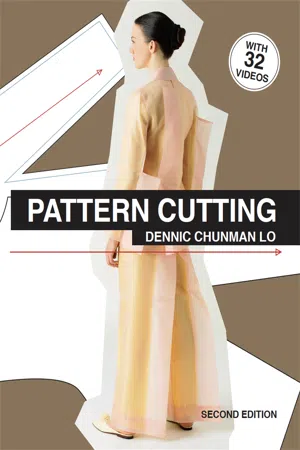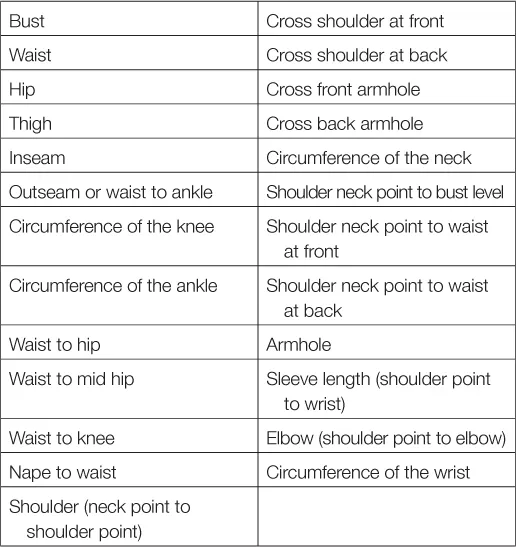
- 300 pages
- English
- ePUB (mobile friendly)
- Available on iOS & Android
eBook - ePub
About this book
This practical guide explains how to take accurate measurements, introduces key tools and takes you from simple pattern-cutting ideas to more advanced creative methods. Step-by-step illustrations show how to create and then fit basic bodice, sleeve, skirt, dress, and trouser blocks, and how to adapt these to create patterns for original designs. New material includes advice on fitting toiles and working with stretch fabrics. There is also a fully updated chapter dedicated to digital technology.
New to this edition: Access to 32 instructional videos
Frequently asked questions
Yes, you can cancel anytime from the Subscription tab in your account settings on the Perlego website. Your subscription will stay active until the end of your current billing period. Learn how to cancel your subscription.
At the moment all of our mobile-responsive ePub books are available to download via the app. Most of our PDFs are also available to download and we're working on making the final remaining ones downloadable now. Learn more here.
Perlego offers two plans: Essential and Complete
- Essential is ideal for learners and professionals who enjoy exploring a wide range of subjects. Access the Essential Library with 800,000+ trusted titles and best-sellers across business, personal growth, and the humanities. Includes unlimited reading time and Standard Read Aloud voice.
- Complete: Perfect for advanced learners and researchers needing full, unrestricted access. Unlock 1.4M+ books across hundreds of subjects, including academic and specialized titles. The Complete Plan also includes advanced features like Premium Read Aloud and Research Assistant.
We are an online textbook subscription service, where you can get access to an entire online library for less than the price of a single book per month. With over 1 million books across 1000+ topics, we’ve got you covered! Learn more here.
Look out for the read-aloud symbol on your next book to see if you can listen to it. The read-aloud tool reads text aloud for you, highlighting the text as it is being read. You can pause it, speed it up and slow it down. Learn more here.
Yes! You can use the Perlego app on both iOS or Android devices to read anytime, anywhere — even offline. Perfect for commutes or when you’re on the go.
Please note we cannot support devices running on iOS 13 and Android 7 or earlier. Learn more about using the app.
Please note we cannot support devices running on iOS 13 and Android 7 or earlier. Learn more about using the app.
Yes, you can access Pattern Cutting by Dennic Chunman Lo in PDF and/or ePUB format, as well as other popular books in Design & Fashion Design. We have over one million books available in our catalogue for you to explore.
Information
CHAPTER 1
PREPARATION
LEARNING OBJECTIVES
• List the four main decisions needed before pattern cutting can begin.
• Outline the different size charts and how they apply to a variety of pattern-cutting scenarios.
• Explain the difference between woven and stretch fabrics, and describe the effects of grainline, gravity and suppression on a garment.
• Discuss the relationship between a two-dimensional pattern and a three-dimensional garment.
• Recognize the elements and requirements of a working drawing.

INTRODUCTION
Common sense is the key to pattern cutting. When trying to make something – whether it is a pillowcase, a cushion cover, a tablecloth, an apron or even a simple quilted case for a laptop – you need to know four things before beginning:
1. The measurements.
2. The intended material.
3. The techniques that will be used to make it; for example, machine stitching, hand stitching, taping, gluing, overlocking, zipping, buttoning and so on.
4. Finally, and perhaps this is the most important point, whether you want to make more than one. If so, you will need to keep a record.
To translate the above in terms of pattern cutting for the garment industry:
1. Before beginning you need to know the measurements required and the sizing system you need to work to.
2. You need to know the fabric from which the garment will be made because this will affect the method you apply to cut the pattern and will also determine the seam allowances in terms of width and method of finishing.
3. To be a good pattern cutter, you also need to understand construction. Pattern cutting is not only working out the shape, it is also about engineering the pieces to fit together to form a garment. To understand how to do this you need to acquire garment construction skills such as sewing or knitting.
4. To make more than one garment you need to be able to record the shape in the form of papter pattern. This is done by perfecting the shape first through a draft pattern and then through toiling and alteration. The resulting pattern(s) can be reused many times throughout the production process.


You will mainly use either pattern card or spot-and-cross paper, but in practical terms you can use almost any type of paper for pattern cutting. Recycled newspaper, for example, might make an economical and interesting set of paper patterns (see here), but only if you can read any marks you might make through the newsprint and the paper does not tear too readily.
An experienced pattern cutter will be able to draft the pattern directly onto real fabric with chalk from a set of measurements. This needs experience, confidence, practice and a lifetime of dedication to one skill. This method, however, can only really be used in home dressmaking or bespoke tailoring because there is no mass production and therefore no need to make a record. For mass production in the garment industry, patterns must be used. These are usually made from plain paper or soft card, card being more durable. However, digital patterns, which are more user-friendly and sustainable, are becoming more prevalent.
Patterns record the shape of the garment accurately. Each part of the garment is drafted separately: sleeve, collar, front, back, yoke, lapel and so on. Sets of paper patterns should be stored, recorded or even archived systematically so they can be reused over a period of time. In the case of computerized pattern cutting, the sets of patterns are stored in digital format and can be plotted, shared by e-mail and reproduced at the click of a button.
Having established the need to record the garment in the form of a pattern, the next stage is usually the creation of a block, which is a basic garment shape from which a pattern for a specific garment can be drafted. You will learn how to draft a block in Chapter 3. Before we begin, however, we will further explore the first two premises listed opposite – measurements and sizing systems and the effect of different fabrics on pattern cutting. There is also a third item a pattern cutter needs before beginning to draft the block or pattern, and that is an idea of the garment they are to create. This comes in the form of a working drawing, which will be explored at the end of the chapter.

MANNEQUINS & MEASUREMENTS
Before you start to cut a block or produce a paper pattern for a garment, you must consider the person for whom you are making the garment. Is it:
1. a garment for yourself? (home dressmaking)
2. a garment for a particular person? (couture/bespoke tailoring)
3. a garment for an assignment at college? (using a mannequin)
4. a garment for a fashion show? (aesthetic based)
5. a garment made professionally for the industry? (realistic, to fit the general public)
Each of these different scenarios will require a different size chart and the selection of a different mannequin for fitting. Please see Chapter 3 for advice on taking measurements.
PERSONAL SIZE CHART
When making a garment for yourself or for a specific person, you can create a unique size chart containing the following measurements:

BNW = Centre back of neck to waistline, or nape to waist (Courtesy Kennett and Lindsell Ltd)
Using a personal size chart will ensure a made-to-measure fit, which is virtually impossible using any other kind of size chart. Tailors, bridalwear designers and haute couturiers not only produce each garment to the exact measurements of their clients, but also use custom-made mannequins (or forms) sized for their most loyal customers; Hardy Amies had a special mannequin for Queen Elizabeth II, as did Givenchy for Audrey Hepburn. Rather than relying on personal measurements alone (no matter how many you take), the best practice when cutting a pattern for one person is to spend time actually fitting the toile to that person.
MANNEQUIN SIZE CHART
Most colleges use a European size 12 mannequin as a standard size, though some are now using a size 10 as the ideal shape slims down on the catwalk. Using a size 10 mannequin is increasi...
Table of contents
- Cover
- Title
- Copyright
- Contents
- About this Book
- Chapter 1: Preparation
- Chapter 2: Taking Measurements
- Chapter 3: Selecting & using Tools
- Chapter 4: The Basic Block
- Chapter 5: Creating Patterns
- Chapter 6: Creating & Fitting the Toile
- Chapter 7: Converting the Block
- Chapter 8: Adding Styles
- Chapter 9: Stretch Fabrics
- Chapter 10: Inspirational Pattern Cutting
- Chapter 11: Pattern Cutting & Technology
- Glossary
- Further Reading
- Software Suppliers
- About the Videos
- Index
- Credits
- Publisher’s Acknowledgements
- Author’s Acknowledgements